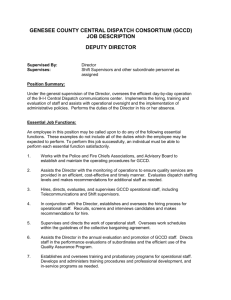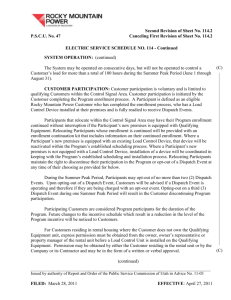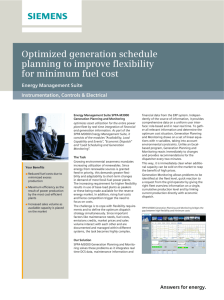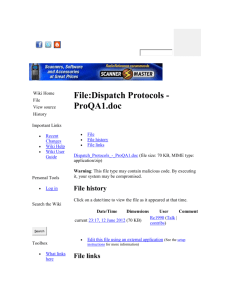Communications - Banks County Government
advertisement
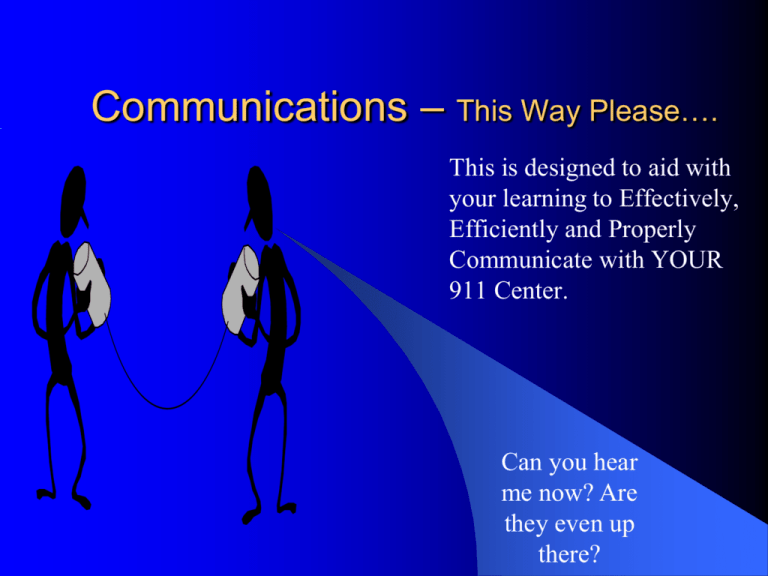
Communications – This Way Please…. This is designed to aid with your learning to Effectively, Efficiently and Properly Communicate with YOUR 911 Center. Can you hear me now? Are they even up there? Communications – That Way Please… And, designed to aid with 911 learning to Effectively, Efficiently and Properly Communicate with YOUR Service. Communications – A 2-Way Street! After all.. WE ARE A TEAM and on the same path, working toward the same goal and here for the same reason. Good Job! Introduction 1st let’s learn who each other are – too often members of the same team don’t know one another in our line of work. Tell us your name and how long you have been in the field. Why are we here? We all wanted to work together to communicate more efficiently. What will we learn today? We will work together to learn together how we can communicate better. What do you want to see come out of the training? What we hope to see come out of the training. Agenda 1. 2. 3. 4. 5. 6. 7. 911 Dispatch Procedures that pertain to you. How does our procedures mesh with yours? FAQ’s To Dos and Not To Dos. Further training opportunities. Summary After Action Ground Rules Please turn your pagers and telephones on vibrate. No question is a stupid question. Anything other than constructive / professional criticism WILL NOT be allowed. Remember that we are a team and our sole goal during this session is to work together to better understand one another and make communications better for us all. There WILL be positive things we identify as well as some issues that we identify. We will work together to forward our findings during this session to Command Staff so that they may address them properly. Let’s Go! Let’s work together to begin putting the Communications Puzzle together. Together we will review the 911 procedures that pertain to you and then answer questions. We Team Us Together Unified Squad Jointly Cohesive Group 911 Dispatch Procedure Important for you to know about our SOP: – We must dispatch in 1-2 minutes from incoming call. 911 Dispatch Procedure Tones: 1. 2. Dispatch currently selects the tones in the following order: 1. Pre-Alerts 2. Fire Admin / or, Homer if it’s a Homer Call 3. Correct District Tones (none of these set if it’s Homer) 4. Correct EMS Tones The new format will be: 1. Correct District Tones (none of these set if it’s Homer) 2. Correct EMS Tones 3. Pre-Alert 911 Dispatch Procedure Our Dispatch format: – Dispatch Med – – Station --– Call Type (all Plain Talk now) – Address – Off Of (or nearest Cross Street) Wait for primary unit to go en-route Repeat where responding Give Short Report While you are en-route, we are expecting return radio info from: Apparatus En-Route, 1st First Responder When you are on-scene, we are expecting: – Ops to go Tactical – All comm with us through Command once on-scene. Note – we are paging / making notifications simultaneously. 911 Dispatch Procedure FTR’s – 3 minutes = 2nd Dispatch ; 3 more minutes = 3rd Dispatch AND BCSO dispatched to Station to check on you. Notifications – made to Command Staff as needed; even if a call comes out as a less significant call and then it changes. In the case that it changes to a more severe event later, we will manually page proper Command Staff. This may mean Fire/EMS Command and may also include 801 and 6D1 along with Commissioners if needed. EMD = Emergency Medical Dispatch – we ask scripted questions verbatim and give directed Pre-arrival Directions; all patient info is given in short report. Short Report is required within 1-2 minutes max of initial dispatch. If it appears it will take longer, we are required to advise stand-by for short report. If lift assistance is needed, Dispatch will advise and send needed personnel. 911 Dispatch Procedure 20 Minute Checks – Done with Command until IC advises no need. – If no answer: timer is set to 3 minutes and if still no answer at 3 minute mark; BCSO is sent to check status. All info IC advises is logged to call. Important info will be repeated to ensure we copied correctly. All MVA’s by 3rd party without specifics are sent out as MVA with Unknown Further. All Smoke Investigations in structures are dispatched as a structure fire. EMS goes on all structure fires in County and Homer, they don’t respond inside Maysville or Baldwin on fires if they are requested by those cities. We have hydrant info in most areas; it will be given in short report. County Water will be notified on large fires to ensure they know about large water usage amounts. 911 Dispatch Procedure If all ambulances are out; we automatically put surrounding on stand-by and will ask the closest to respond if we need them. This is followed up with a page to Command Staff. We also rotate EMS as needed by paging them out. Page tests are still being done, please let us know how you copy when these are done. Routine Unit Logs are kept; please let us know if you are on an apparatus and you are doing testing for example. This will be logged to the unit for record keeping. We will place a helicopter on stand-by if needed. We won’t launch until advised to do so by IC. If the Paramedic needs to speak with the E.R.; we will conference them so that they are recorded. If we have 2 ambulances available and another neighbor county calls for mutual-aid; we will send it and let Command Staff know. 911 Dispatch Procedure We do not advise you to stage away; we will give you all info we have (that we are able to give) and you should use your training to determine staging need. Fire Alarm calls will be followed up on with a phone call after units are enroute. We will not cancel units but will pass on any information we find. 510 responds with Homer on all structure fire and fire alarm calls; Homer does likewise for 510. We do monitor TAC (becoming Fireground); it is on our consoles. In the very near future, we will also have a Public Safety Repeated operations channel that may be used. Any and all complaints will be handled by putting it in writing, giving it to your Command and the two proper Command Staff will resolve the problem. Homer Fire has agreed to abide by all of these procedures. Fire / EMS info (other than times) will not be released without approval from 501 & 6D1. 911 Dispatch Procedure Times will be faxed as soon as all units are back in-service from the call; if there is GCIC information on the call report – the call will be printed and this information will be redacted. If you need times sooner, please call. And, please let us know if you don’t receive them within 15 minutes units being back in-service / in-station. LASP is automatically dispatched by phone if it is a County Structure Fire; we do not send them on city structure fires unless requested. Again, our EMS doesn’t respond to any structure fires in any city unless it is in Homer or if they are requested. Hall County Fire is 1st due in many areas inside Gillsville and Lula; see the lists. Collyer’s Mansion residents will be given on short report if we have the info. District 2 & 4 aid one another on certain roads for MVA’s; see the list. Brian Smith is the Fire Investigator that we use. We notify him if IC advises to do so. 911 Dispatch Procedure Codes / Case Number and their relationship. Some codes have been established in order to ensure additional and unneeded case numbers are not pulled. See the list in the SOP. – Follow your SOP in relation to what you use (CAD # or CASE #) and where you put these in your reporting software. First Responders are dispatched on all calls (except to the Jail or as directed by 501.) 330 responds in the City Limits of Maysville for Maysville Fire response. Non-Emergency Transports – if Northridge calls; we ask if they’ve tried a transport service or Jackson, if they have and still have no help; we call 501 for instruction. SAR K9 – we dispatch on authority of 501 and are directed on steps to take. 10 MINUTE BREAK TRIVIA QUESTIONS: DID NARROWBANDING REQUIRE US TO BE P25? WHAT IS P25? WHAT FREQUENCY SPECTRUM ARE WE OPERATING IN? So, how do the 2 SOPs mesh? Do the two mesh together or does one contradict the other? Give an example of contradictions or how they are working well together. Local Communications FAQ’s Are we Narrowband? Yes. What towers do we have? 911, Banks Crossing, Davis Academy, Grady, Baldwin Mountain, Mt. Carmel Will we need more sites? Yes, we know we will need coverage on the West and Southwest portions of the County as well as somewhere along Hwy 63. What frequency spectrum are we? VHF Can you get the frequencies and PL tones from us? No; only the 911 Director can release those with approval from the proper entity operating on that frequency. Do we have any redundancy? What happens if your repeater goes down? Right now we have an off-line back-up in the Dispatch room that simply has to be plugged in to bring it back up; as soon as Baldwin is finished we will have ability to swap to a back-up with the push of a button. Do we have a back-up frequency? Yes, you have a Public Safety Repeater that will be operational as soon as Baldwin is up and you also have Fireground as well as Vfire and Vmed channels you can use from the NIFOG. What are our future radio plans? We have no plans to go to 800Mhz. We may go digital at some point in the future. The Communications Committee are working on 1 – 5 – 10 Year Plans now. SPLOST dollars will fund some of these projects identified. Is our tones changing? No. How do we talk to surrounding Counties on other systems? We do have interoperability capability with the Motobridge. It patches unlike bandwidths together and our new radio consoles will do the same. In addition, Command Staff have been issued 800 radios to communicate with Hall and in the near future they may be issued others to also help. Visits to 911 are permitted with Command Staff permission coordinated through the 911 Director. We do provide a wide variety of reports; if you need those reports let the Chief know and he will communicate the need to the Director and assign someone to get the report. We at Banks County E-911 believe that we are a valuable resource to you and will always work to improve and offer you the highest quality dispatch that is possible. To Dos and Not To Dos Do: Follow the Chain of Command. Forward any comments (positive or negative) through the Fire Chief and the Fire Chief will work with the Director to handle all needed. 911 is instructed likewise. Don’t complain to the public, others in our department or yours – remember, a finger pointed at someone else on the team causes 4 to be pointed right back at you. Do: Use clear text; speak clearly and at an appropriate audible level. Don’t use codes or slang; laugh or cut-up. Remember to be professional. Do: Use the radio if you are among the 1st First Responders and if you are on Apparatus responding and if you are IC. If you are a First Responder, be short and concise (ex: 501 Dispatch Enroute – all in one breath). Don’t use the radio if you are not in apparatus and the IC has Code 4 the scene. Remember that your number will be reflected on the IC accountability as well; and Volunteers not in apparatus can obtain assignment from IC when on-scene. Do not walk on one another; this happens with too much traffic. Do: Use a Tactical Channel (as assigned by IC) for ops on scene. Don’t cover the primary repeater with unneeded traffic that can be handled on a side channel. Remember, your brother may need help and 911 may need to send out more help. Do: Call us on 706-677-1234 if there is something that just can’t go over the radio. Don’t call us with traffic that could and should go over the radio. Remember our room is very busy during calls; we only have 2 – 3 people and four 911 trunks with 7 admin lines and 4 radios. Your call may prohibit an emergency call getting through. Don’t use 911 to call us unless you have an emergency! Do: Give time for the short report. Don’t immediately ask a bunch of questions about the call. Give us just a moment as we are trained to provide a short report with location of incident and closest cross streets once the primary apparatus is enroute. Do: Remember to key and then count to two in your head before speaking and hold your microphone away from your mouth to ensure your transmission is clear. Don’t clip yourself or muffle your transmission. Do: Remember to step away from your partner when talking. Don’t key your radio next to or near another radio; it causes a squelch that hurts our ears. Remember that we have on a headset which focuses that noise straight into our ear canal. More Comm Training & Information Ride-Alongside 911 as they operate - as set up by the Chief and Director Allow 911 to ride alongside you as you operate – as set up by the Chief and Director Motobridge training – the State is working on the site and will have it prepared soon. You will also be able to access a Radio Basics / Radio 101 class on the Motobridge link. www.FCC.gov FEMA IS-704 NIMS Communications Local Communications Exercises www.nd.gov/des/training/basic-radio-101/ this is a North Dakota site that gives good basic radio knowledge to the end user. This class will be much like the radio basics module that will soon be available on the Motobridge link. Summary We are YOUR 911 Center. We are here for YOU. We are on YOUR TEAM. Most Importantly: – We are ALL here for OUR citizens! – And, WE owe them OUR BEST! Let’s work TOGETHER for the betterment of 911 and all emergency services. AFTER ACTION / CLOSING We will take the notes we made during this session and forward them to the Chief and Director and ask that they answer / address any questions, concerns or comments. Thank you for allowing us the time to speak to you tonight. We think we have the best team around!


